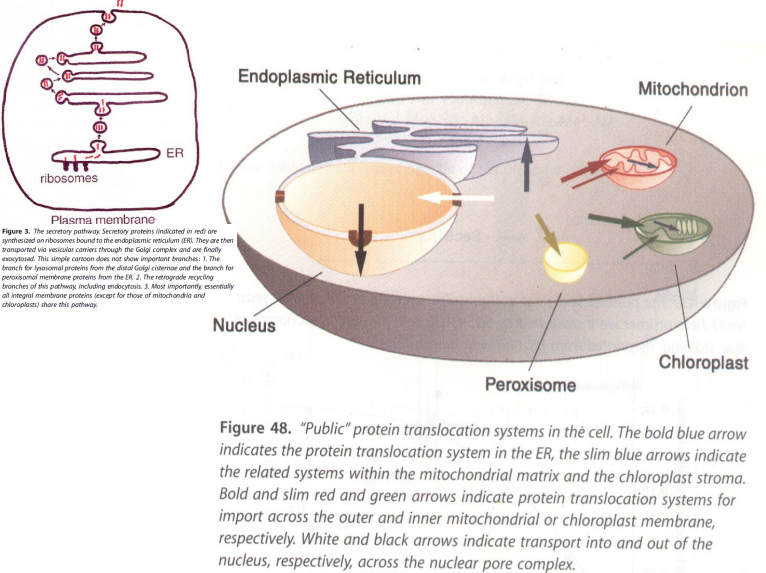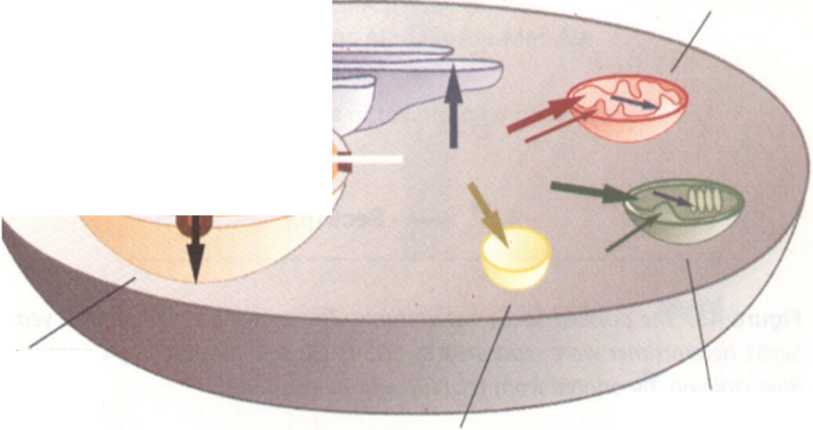public

Endoplasmic Reticulum
Plasma membrano V
Figurę 3. rht inrelcy poth<vo/. Wirtw/ protefis ttn&<coltd in w# orr
onnboKiwej tootK) to nie enc»p(asmic rci<uV.m «TRl Jhtyat rhm trantpomd \<o Mifeutar coir.toj rMajgb rhr Gol? caroplei ati1 a* tV-v?V «0£yt0i*r. nm fOfMOft tto* no: iW Sfoporianf tnmcha: I. The
irantA kr ł/wtcmol proAr-in tom rtw d»lol Gofy otfrmor and IV hw*A fo' (K.Ku»t\rv< mtmkronr prctrms 6w» theW J, The r<ra»jet»^r irencftn oflhi pcthw* .rKfodSig tnctooroiu. J. Mm* inwrentt/. asenda\V at Vi«grol /nemiwne prc<»V.s for thoie ot mi>xAcr>3-.U oi* oMo-opOoSiJ ifuvc tfat putAwoy
Mitochondrion

Chloroplast
Peroxisome
Figurę 48. "Public"protein translocation systems in the celi. The bold blue arrow indicates the protein translocation system in the ER, the slim blue arrows indicate the related systems within the mitochondrial matrix and the chloroplast stroma. Bold and slim red and green arrows indicate protein translocation systems for import across the outer and inner mitochondrial or chloroplast membranę, respectively. White and black arrows indicate transport into and out of the nucleus, respectively, across the nuclear porę complex.
Wyszukiwarka
Podobne podstrony:
AMiMAlL CEUl STRUCTURE Smooth endoplasmic reticulum Plasma membranę Centrioles Chromatin Nucleolus
Figurę (Chapitre 1) : IIypoxia (riggers furin relocalization lo the basal plasma membranę HT- 1080-e
Spis treści 2(1) IX Contents Endoplasmic Reticulum and Golgi Apparatus Carbohydrate
SSC031 Siateczkaśródplazmatyczna Ziarnista RER (rough endoplasmic reticuluni) cysterny siateczki pok
SSC040 Siateczka śródplazmatyczna gładka Smootti endoplasmic reticutum SER Nie występuje w erytroc
desesperer la mechancete des hommes. Le public etait emu par cette figurę angeliąue et myste-rieuse
Struktura komórki roślinnej Nucleus Rough ER Smooth ER Ribosomes Plastid Chloroplast Microtubules Pl
5 28 Extensor indicis Interossęus membranę Figurę 5-28 Anatomy of extensor pollicis longus, dorsal (
komórki gram dod Peptidoglycan (a) Gram-positivc Celi wali Plasma membranę S nm Gram- Ji negative&n
NLs Transport to the nucleus (NLS) -Pro-Pro-Lys-Lys-Lys-Arg-Lys-Val- Transport to the endoplasmic re
5 27 Supinator Abductor pollicis longus Proximal attachment to dorsal radius and interosseus membran
5 37 Flexor digitorum profundus Median nerveInterosseus membranę Figurę 5-37 Anatomy of flexor digit
5 39 Median nerve Flexor digitorum profundus Flexor pollicis longus Interosseus membranę Figurę 5-39
The Plasma Membranę Polar head of phospholipid molecule Exiracellular fluid (walety
Endoplasmic reticulum nudear porę / nudear envelope smooth endoplasmic reticulum cisternal
N uijŁear wivek>fi£ Sfltiwth antfoDlasjflfe reticulumThree-Dimensional Endoplasmic Reticulum
DSC)50 endoplasmic reticulum DNA andassociatep proteina (chromatin) nucleolus microtubule nucie ar
więcej podobnych podstron